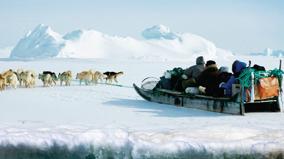Katinniq
ᕿᒧᔅᓯᖅ ᐅᓯᔪᖅ ᐃᓄᒡᕼᐅᐃᑦ ᐃᓚᒌᓂᑦ ᐃᖏᕐᕋᕗᑦ ᓯᕕᑐᔪᒃᑯᑦ ᓯᑯᒃᑯᑦ ᐊᑯᑭᑦᑐᓂᑦ. ᓯᑰᑉ ᐊᑖ ᐊᐅᑉᐸᓕᐊᑎᓪᓗᒍ --- ᕿᒻᒦᑦ ᒪᐅᕙᑉᐳᑦ ᐃᖏᕐᕋᓂᕐᒥᓂ, ᐃᒫᓚᐅᖅᐸᑦᑐᑎ. ᓇᕙᕋᓇ, ᐃᓐᓇᖅ ᐊᒻᒪᓗ ᖃᒧᑎᒥᑦ ᐃᑭᒪᔪᖅ, ᐊᖏᕈᑎᖃᖅᑯᖅ ᓂᕆᐅᓇᓐᖏᑦᑐᓂᑦ ᐊᓯᔾᔨᐸᓪᓕᐊᔪᓂᑦ ᐅᑭᐅᖅᑕᖅᑐᒥᐅᑕᓕᒫᓄᑦ ᓴᖅᑭᐅᒪᔪᓂᑦ. 1860-ᖏᓐᓂᑦ ᓇᕙᕋᓇᐅᑉ ᓯᕗᕚᖓ ᑕᑯᓐᓇᒐᖃᓲᖅ --- ᐊᖓᒃᑯᖅ ᕿᑭᖅᑖᓗᒻᒥᐅᑕᖅ, ᑲᓇᑕᒥ ᐊᑎᓕᒃ ᕿᓪᓚᖅᓱᐊᒥᑦ --- ᐃᖏᕐᕋᓚᐅᖅᓯᒪᕗᖅ ᐊᔾᔨᐅᖏᑦᑐᒃᑯᑦ ᑲᔾᔮᓇᖅᑐᒃᑯᑦ, ᓯᕗᒃᑲᑕᖅᑐᓂ ᐃᓅᖃᑎᖏᓐᓂᑦ ᐊᑯᑭᑦᑐᓕᐊᖅᑐᑎ. ᑖᔅᓱᒪ ᐊᖓᒃᑰᑉ ᐃᓚᒌᓕᖅᑐᑎ ᑭᖑᕚᖃᓕᖅᑐᓂ ᓇᕙᕋᓇᒃᑯᓐᓂᑦ ᑐᓴᖃᑦᑕᐅᑎᓕᕆᓂᒃᑯᓪᓗ ᐊᒻᒪᐃᓪᓗᓂ. ᐊᕐᕌᒍᐃᑦ 150 ᐅᖓᑖᓄᑦ, ᓇᕙᕋᓇ ᕿᓪᓚᖅᓱᐊᑉ ᐃᖏᕐᕋᕕᒥᓂᖓᓂᑦ ᑐᔾᔭᐃᓯᒪᕗᖅ ᐅᑎᒧᖔᖅ ᑲᓇᑕᒧᑦ ᐊᒻᒪᓗ ᐳᓚᕋᓕᖅᑐᓂ ᑲᓇᑕᒥᐅᑕᓄᑦ ᐃᓪᓗᒃᑯᖏᓐᓄᑦ. ᓇᕙᕋᓇ ᐃᓚᒥᓂ ᐃᓚᖃᖅᑐᓂ ᑕᒪᒃᑮᓂᑦ ᐊᑯᑭᑦᑐᕐᒥᐅᓂᑦ ᑲᓇᑕᒥᐅᓂᓪᓗ ᐊᕐᕌᒍᑕᒫᖅᓯᐅᑎᖏᓐᓂᑦ ᐊᓯᕙᖃᑎᖃᖅᑯᖅ. ᑕᑯᔭᖃᖅᑯᕐᓗ ᐊᔾᔨᒌᓐᖏᓐᓂᖏᓐᓂᑦ ᐊᑦᑐᖅᑕᐅᓯᒪᓂᖏᑦ ᓯᓚᑎᒥᓄᑦ ᐊᒻᒪᓗ ᕿᒪᐃᓐᓇᕋᔅᓴᐅᖏᑦᑐᓂᑦ ᐊᓯᔾᔨᖅᑐᓂᑦ ᐊᓯᕙᕐᓂᕆᕙᑦᑕᖏᑕ ᐱᔾᔪᓯᖏᓐᓄᑦ. ᐊᑐᖅᓯᒪᔭᖏᑎᒍᑦ, ᓇᕙᕋᓇ ᓂᕆᐅᑉᐳᖅ ᓇᓗᓇᐃᔭᖅᓯᒪᑦᑎᐊᖅᑐᓂ ᐊᒻᒪᓗ ᐱᓪᓗᐊᑕᓂᑦ ᓱᓕᔪᓂᑦ ᓴᖅᑮᔪᒫᖅᑐᑦ ᐃᓱᒪᓕᐅᕈᑎᑦᑎᐊᕙᐅᓗᓯ ᐊᓐᓇᐅᒪᓂᒃᑯᑦ. ᖁᕕᐊᓲᑎᖃᖅᑯᖅ ᑖᒃᑯᐊ ᓄᓇᓖᒃ ᑲᓲᑎᕙᓐᓂᖏᓐᓄᒃ, ᓇᕙᕋᓇ ᐱᔪᓐᓇᓂᕐᒥᑦ ᓂᕆᐅᓐᓂᖃᕐᓂᒥᓪᓗ ᒪᑭᒪᔾᔪᑎᖃᖅᐸᑉᐳᖅ ᓯᕗᕚᖏᑕ ᐆᒻᒪᔾᔭᕆᓚᐅᕐᓂᖏᓐᓄᑦ …

Details
1860-ᖏᓐᓂᑦ ᓇᕙᕋᓇᐅᑉ ᓯᕗᕚᖓ ᑕᑯᓐᓇᒐᖃᓲᖅ --- ᐊᖓᒃᑯᖅ ᕿᑭᖅᑖᓗᒻᒥᐅᑕᖅ, ᑲᓇᑕᒥ ᐊᑎᓕᒃ ᕿᓪᓚᖅᓱᐊᒥᑦ --- ᐃᖏᕐᕋᓚᐅᖅᓯᒪᕗᖅ ᐊᔾᔨᐅᖏᑦᑐᒃᑯᑦ ᑲᔾᔮᓇᖅᑐᒃᑯᑦ, ᓯᕗᒃᑲᑕᖅᑐᓂ ᐃᓅᖃᑎᖏᓐᓂᑦ ᐊᑯᑭᑦᑐᓕᐊᖅᑐᑎ. ᑖᔅᓱᒪ ᐊᖓᒃᑰᑉ ᐃᓚᒌᓕᖅᑐᑎ ᑭᖑᕚᖃᓕᖅᑐᓂ ᓇᕙᕋᓇᒃᑯᓐᓂᑦ ᑐᓴᖃᑦᑕᐅᑎᓕᕆᓂᒃᑯᓪᓗ ᐊᒻᒪᐃᓪᓗᓂ. ᐊᕐᕌᒍᐃᑦ 150 ᐅᖓᑖᓄᑦ, ᓇᕙᕋᓇ ᕿᓪᓚᖅᓱᐊᑉ ᐃᖏᕐᕋᕕᒥᓂᖓᓂᑦ ᑐᔾᔭᐃᓯᒪᕗᖅ ᐅᑎᒧᖔᖅ ᑲᓇᑕᒧᑦ ᐊᒻᒪᓗ ᐳᓚᕋᓕᖅᑐᓂ ᑲᓇᑕᒥᐅᑕᓄᑦ ᐃᓪᓗᒃᑯᖏᓐᓄᑦ.
ᓇᕙᕋᓇ ᐃᓚᒥᓂ ᐃᓚᖃᖅᑐᓂ ᑕᒪᒃᑮᓂᑦ ᐊᑯᑭᑦᑐᕐᒥᐅᓂᑦ ᑲᓇᑕᒥᐅᓂᓪᓗ ᐊᕐᕌᒍᑕᒫᖅᓯᐅᑎᖏᓐᓂᑦ ᐊᓯᕙᖃᑎᖃᖅᑯᖅ. ᑕᑯᔭᖃᖅᑯᕐᓗ ᐊᔾᔨᒌᓐᖏᓐᓂᖏᓐᓂᑦ ᐊᑦᑐᖅᑕᐅᓯᒪᓂᖏᑦ ᓯᓚᑎᒥᓄᑦ ᐊᒻᒪᓗ ᕿᒪᐃᓐᓇᕋᔅᓴᐅᖏᑦᑐᓂᑦ ᐊᓯᔾᔨᖅᑐᓂᑦ ᐊᓯᕙᕐᓂᕆᕙᑦᑕᖏᑕ ᐱᔾᔪᓯᖏᓐᓄᑦ. ᐊᑐᖅᓯᒪᔭᖏᑎᒍᑦ, ᓇᕙᕋᓇ ᓂᕆᐅᑉᐳᖅ ᓇᓗᓇᐃᔭᖅᓯᒪᑦᑎᐊᖅᑐᓂ ᐊᒻᒪᓗ ᐱᓪᓗᐊᑕᓂᑦ ᓱᓕᔪᓂᑦ ᓴᖅᑮᔪᒫᖅᑐᑦ ᐃᓱᒪᓕᐅᕈᑎᑦᑎᐊᕙᐅᓗᓯ ᐊᓐᓇᐅᒪᓂᒃᑯᑦ.
ᖁᕕᐊᓲᑎᖃᖅᑯᖅ ᑖᒃᑯᐊ ᓄᓇᓖᒃ ᑲᓲᑎᕙᓐᓂᖏᓐᓄᒃ, ᓇᕙᕋᓇ ᐱᔪᓐᓇᓂᕐᒥᑦ ᓂᕆᐅᓐᓂᖃᕐᓂᒥᓪᓗ ᒪᑭᒪᔾᔪᑎᖃᖅᐸᑉᐳᖅ ᓯᕗᕚᖏᑕ ᐆᒻᒪᔾᔭᕆᓚᐅᕐᓂᖏᓐᓄᑦ ᐅᓪᓗᒥᐅᓕᖅᑐᖅ ᓯᓚᕐᔪᐊᕐᒥᑦ ᐅᑭᐅᖅᑕᖅᑐᒥᑦ ᐃᓄᐃᑦ ᐅᓇᒻᒥᓇᖅᑐᓂᑦ ᐊᑐᖅᑕᒥᒍᑦ ᐃᓅᖃᑎᒌᓐᓂᒃᑯᑦ ᐊᒻᒪᓗ ᐊᕙᑎᓕᕆᓂᒃᑯᑦ.
Click here for the English version
Click here for the Greenlandic version, Katinngat
-
directorStephen A. SmithJulia Szucs

















